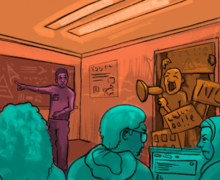Health experts predict campus won’t close early if SU controls virus spread
Sarah Allam | Illustration Editor
Syracuse started its fall semester classes on Aug. 24.
The Daily Orange is a nonprofit newsroom that receives no funding from Syracuse University. Consider donating today to support our mission.
Syracuse University could remain open through the fall semester if a second wave of coronavirus’ infections remains controlled in surrounding areas, according to public health experts.
A second wave of COVID-19 infections in the United States will likely occur as transmission of the virus increases in the fall, public health professors and epidemiologists told The Daily Orange. Whether in-person instruction at SU outlasts that second wave depends on how central New York is impacted, they said.
“All the pieces are in place for (SU) to come out (with) an adequate response,” said Brooks Gump, a public health professor at Falk College. “If there is an outbreak, it doesn’t mean we necessarily have to shut down the university.”
SU started its fall semester Monday, inviting students back to campus for a mix of in-person and online instruction. The university has said it will pause in-person classes and restrict students to their dorms if more than 100 students contract COVID-19 and SU loses confidence in its ability to trace additional cases.
Several infections have cropped up at SU since students returned to campus, with nine current active cases among SU students in the central New York area. There are 26 students currently in quarantine.
The university expected the cases, as it presumed students would arrive on campus with infections, said Dave Larsen, an associate professor and environmental epidemiologist at SU. Larsen served on SU’s Public Health and Emergency Management Subcommittee, the group tasked with advising administrators about the health implications of reopening.
To prevent infected students from spreading the virus upon arrival, the university decided to conduct two rounds of testing on students before the semester even began. Students underwent a pre-arrival test before traveling to campus and took another test once they arrived.
The back-to-back testing set SU apart from other universities that saw outbreaks after reopening, Larsen said.
The University of North Carolina at Chapel Hill and the University of Notre Dame both moved to online instruction about a week after bringing students back to campus. Notre Dame sent testing kits to students in mid-July but did not test students upon their arrival to campus. UNC did not require students to get tested before coming to campus and did not test them when they arrived.
The biggest factor in UNC and Notre Dame’s inability to reopen successfully was the high presence of the COVID-19 in their respective communities beyond campus, Larsen and Gump said. Neither university should have reopened given the high COVID-19 positivity rates in their states, they said.
Indiana, where Notre Dame is located, had a 7-day positivity rate of 7.8% on Aug. 18 when the university moved classes online, according to WNDU-TV. North Carolina reported a similar positivity rate of 7% when UNC closed Aug. 17.
New York state’s daily positivity rate recently fell below 1%.
“We wouldn’t try this if we were in the same situation as UNC and Notre Dame,” Larsen said.
The U.S. as a whole still remains at risk for a second wave of COVID-19 infections, said Kathryn Anderson, an expert in infectious diseases and global health at Upstate Medical University.
Anderson’s concerned that transmission of the virus will increase during the cold weather months as people spend time indoors. But she’s hopeful that central New York is prepared to control and slow the spread of cases if transmission does begin to rise again.
“What we as a community should be doing to prepare is take a step back and look at the larger picture for our community,” Anderson said. “If our priorities are, ‘we want our neighbors to get back to work and our kids to get back to school,’ we cannot go into the fall and be frivolous with our adherence to these measures.”
Larsen expects transmission rates to start rising in mid-September and anticipates that many universities in the country will transition to online instruction at that point, particularly those in hotspot states.
SU students will not return to campus after Thanksgiving break and will instead take their final exams virtually. This measure will prevent students who are returning home to hotspot states from bringing the virus back to central New York, Larsen said.
Overall, SU should be able to remain open until the end of the fall semester so long as it can quickly control infections when they arise, Larsen said.
“If we’re still seeing (numbers) rise, that’ll be a concern, but I’m optimistic,” Larsen said.
Bringing SU students back to campus does not pose a risk to the greater Syracuse community “in the way that it was done,” Gump said. Anderson is hopeful that central New York will maintain a low, stable transmission rate going into the spring.
“It’s just going to be dependent on how the community can keep up these measures,” she said.
Larsen was pleased with the way SU listened to science and public health experts when establishing its guidelines. If central New York can prevent a serious outbreak of the virus, so can SU, he said.
“I do not think that it’s inevitable that we will see a spike here in Onondaga County, or here in New York,” Larsen said. “I think it’s a challenge, and I hope we rise to that challenge, but it’s not inevitable.”
Published on August 27, 2020 at 12:00 am
Contact Sarah: scalessa@syr.edu | @sarahalessan






